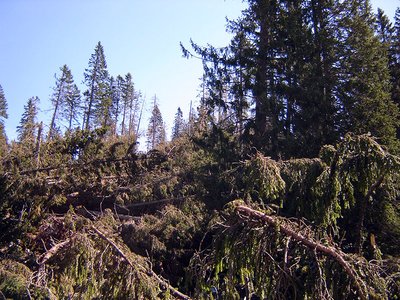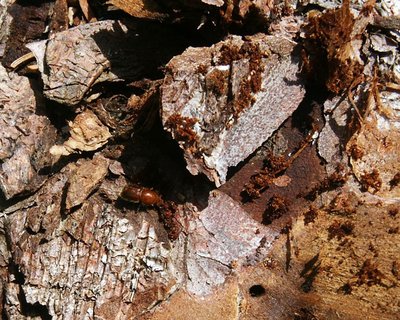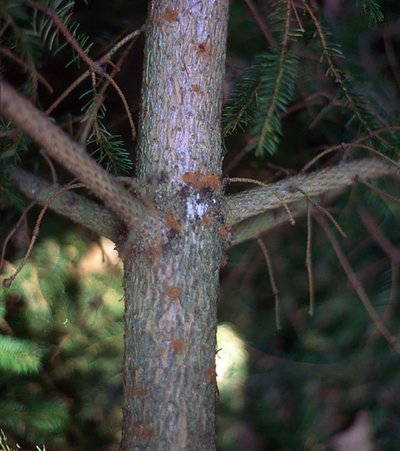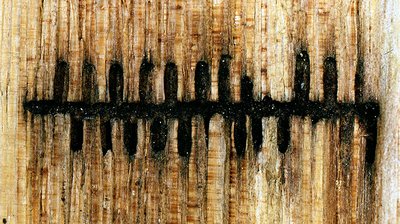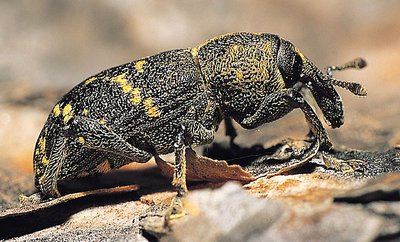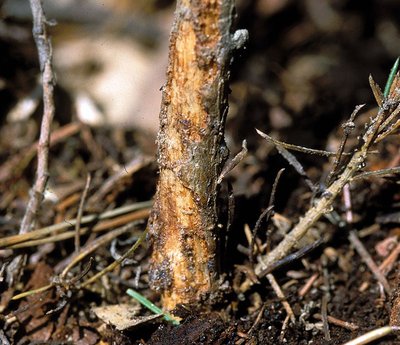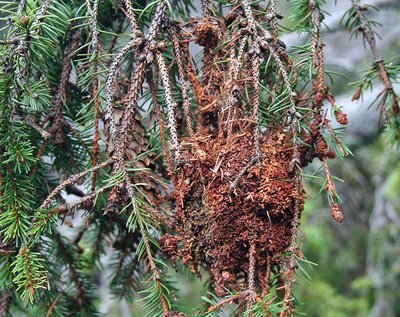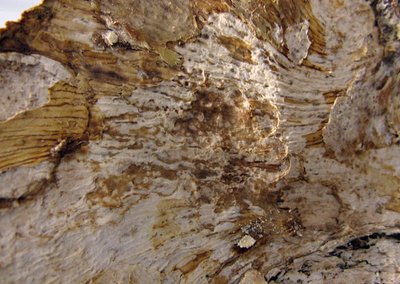With regard to forest protection, the spruce is the most critical tree species in central Europe. Despite 50% damage rates over many years it was still possible to successfully manage the forest for spruce in the past. In the future, storms (Fig. 1) and dry spells will become more common as a result of climate change. At the same time, high temperatures will lead to a shorter time required for the development of bark beetle species and will result in the production of more generations per year.
Damage through insects
Even though multiple insects species can be found on spruce, only a few of them produce grave damage on a stand level. In the future an array of damaging insects could take on greater significance.
Thirty-nine bark beetle species use the bark, wood, or roots of the spruce has a host. Bark beetles are generally a secondary pest and usually require previous damage or weakening of its host plant. However, in sufficiently high population and attack densities, the European spruce bark beetle and the six-toothed spruce bark beetle are even capable of infesting healthy trees. This makes both species the most dangerous insect pest of the spruce.
The 4.2 - 5.5 millimeter large European spruce bark beetle (Ips typographus) bores itself into the thick barked boles of trees and older timber (Fig. 2). The 1.8-2 millimeter large six-toothed spruce bark beetle (Pityogenes chalcographus) is responsible for infestations on standing juvenile spruce trees (Fig.3) and infests the thin barked canopy areas of older spruce trees. The larvae develop underneath the bark in the cambium and produces typical brooding symptoms consisting of galleries from the larvae and female beetle. Depending on the temperature, the development of the larvae can take six to ten weeks. Both bark beetles have an enormous swarming potential. Under the current climate conditions they can, dependent on climatic conditions, produce two to three generations in one year. Furthermore numerous sister generations are also produced.
Currently, the fir bark beetle (Pityophthorus pityographus) is appearing more often. The 1 - 1.5 millimeter large beetle produces only two generations per year with times of flight in May and July/August; sister generations are also possible. As represented by its size, this beetle infests the plants with the thinnest of bark and is thus a relevant forest protection plantation pest, particularly in times of drought.
Bark beetles that brood in wood can produce considerable damage to timber in storage. The striped ambrosia beetle (Trypodendron lineatum) requires low wood moisture in order to successfully cultivate its ambrosia fungus in its galleries. (Fig. 4).The larvae will later feed on the hyphen of the Ambrosia.
Infestation of standing trees is possible in dry periods and will most likely become more common in the future. The species belongs to a group who swarm early and infestation can already be observed by the end of May. One generation is produced per year, however, there is evidence of a possible second generation. It is certain that sister generations do not arise.
The large pine weevil (Hylobius abietis) is as always one of the largest dangers to conifers during stand establishment (Fig. 5). Besides spruce, this beetle also infests Douglas fir, larch and silver fir. In the vegetation period the beetle flies during two phases: after the winter at the end of April till the beginning of May and when the first young beetles participate in breeding at the end of July till beginning of August. For reproduction, the beetle requires fresh conifer branches (up to two years old). The beetles feed on the bark of old trees in the canopy and on individual sites on the trunk and branches. The bark on small stems of young plants, preferably on the root collar, will be fed upon (Fig. 6). As a result, juvenile coniferous stems within close proximity to one another and young stands provide optimal conditions for the creation mass propagation.
One of the most significant forest pests is the nun moth (Lymantria monacha); it is found everywhere in Bavaria on spruce and pine. Mass propagations tend to be located in low land hill country (till approximately 800 m above sea level) and especially in areas with yearly precipitation levels between 400-700 millimeters. The caterpillars of the nun month feed on needles as well as leaves, however, it is a primary pest of wide ranging spruce and pine stands. The nun month is a pest that will produce a mass propagation within two years time directly after latency. In spruce stands, a single defoliation by the moth is enough to kill an entire stand within one year. The eggs hatch in April and the larval development lasts till July and comprises of 5-6 stages. The larvae will feed on buds and newly formed needles (produced in May). Later on they will feed on older needles and eat holes in leaves (one can find the remains of leaves and needles on the ground which the larvae have only partially consumed). From the middle of May till the beginning of June the nun will pupate and after twenty days a moth will emerge in July/August. The moth will fly and lay eggs until September; the eggs will overwinter under the bark scales.
Mass propagation of the web spinning sawfly (Cephalcia abietis) usually occurs in 60-120 year old pure stands in altitudes between 600-1,000 meters above sea level, rarely in low lands. If complete defoliation takes place on the new sprouts in May then the death of the tree is possible. If mortality does not take place then growth will be inhibited. As a result, spruce infested with the wasps are at a significantly higher risk to be infested later by the bark beetle. The wasps swarm primarily from the middle of May till the middle of June during sunny weather. The females lay four to twelve eggs in the crown encircling the older needles. Depending on the temperature the larvae will hatch two to four weeks later. Maturation feeding of the larvae starts in the top of the crown and continues downward on the sunny side of the crown and lasts six - eight weeks. Needles that have been bitten off the tree will be consumed in webs (nests) which will in turn fill up with feces and needle remains (Fig. 7). In August/September the larvae fall to the forest floor and burry themselves five to thirty centimeters deep in the mineral soil where they will remain for the next one to three years.
Damage by fungus
Fungal damage on spruce are currently much less noticeable than those by insects, however, there are a number of noteworthy symptoms.
There are nine different types of Armillaria root rot species described in Europe whose exact identification based on its reproductive parts is possible, but difficult. Armillaria root rot (Armillaria) occurs all over the world and primarily feed saprophytically on dead woody material in the soil. They therefore play an important role in the nutrient cycle in the ecosystems of the forest. However, the Armillaria root rot species could turn parasitic when the host species becomes weakened enough. Factors which favor infestation include, drought stress, water logging, root injury, frost, planting shock, insect and (leaf) fungal infestation plus light and nutrient deficiency or even pollution.
The infection takes place through spores on large wounds or as an infection of the roots through special distributive organs, the rhizomorphs. Infections of the stumps of live trees can take place through root growths or through soil rhizomorphs; then the white mycelium mat covers can be seen (Fig. 8). The fungus can be found in the cambial area where it will successively kill the tree and spread out as white rot in the rest of the woody material. The saprophytic form is a string like mycelium that is surrounded by a brown-black bark like structure. The planar mycelium is only found in the parasitic form in living trees. If the tree can't defend against the infestation then the Armillaria root rot will girdle and kill the tree within a few weeks. Otherwise heart rot will develop over the years where typical black lines of demarcation display the distribution of the fungus.
The red rot of the spruce can be caused by various fungi, however the most important pathogen is the annosum root rot (Heterobasidion annosum). This fungus causes a typical root rot which moves up the tree and causes a white rot in the heartwood which in turn leads to a massive devaluation of the stem. The parasitic lifestyle in the roots is contrary to the saprophytic lifestyle of the fungus in the stem. The distribution in the stem is dependent on tree species. Outside of the spruce other trees infested include pine, larch and Douglas fir.
The infestation takes place primarily through the roots, but partially through spores in rainwater that come into contact with the roots and germinate (primary infestation). Additionally, root contact with infested trees is another source of transmission. Stumps of trees which have been felled can still accumulate spores of the annosum root rot up to four weeks after felling. Peak spore production is reached in early autumn and felling operations during this time dramatically increase the risk of infestation. Additionally, injuries to the roots or to lower part of the stump as well as soil compaction also favor conditions for infestation.
Outside of the rots originating from the roots there are also rots which permeate through injuries on the stem. Sources of injury are typically those occurring through the harvest of timber and bark peeling from red deer. A typical pathogen on the spruce is the bleeding Sereum (Stereum sanguinolentum).
The sirococcus blight is caused by the fungus Sirococcus conigenus and infests the youngest sprouts which will then typically curl and shed their needles. Quite often a "flag" is left on the tip of the sprout which is comprised of the bushel of brown immature needles which were infested shortly after bud break. The crown of trees infested over multiple years will show signs of transparency starting from the outside of the crown to the inside. This disease is found all over Bavaria but is primarily concentrated on the nutrient poor sites of the lower mountain ranges in eastern Bavaria. Causes of the blight are nutrient disturbances, primarily deficiencies in magnesium and poor magnesium:nitrogen ratios in the needles. Additionally, shady areas and locations with high levels of humidity are favorable for infestation. The infestation takes place in the early summer and summer months. If the infestation continues and becomes chronic it could cause the death of the affected spruce.

